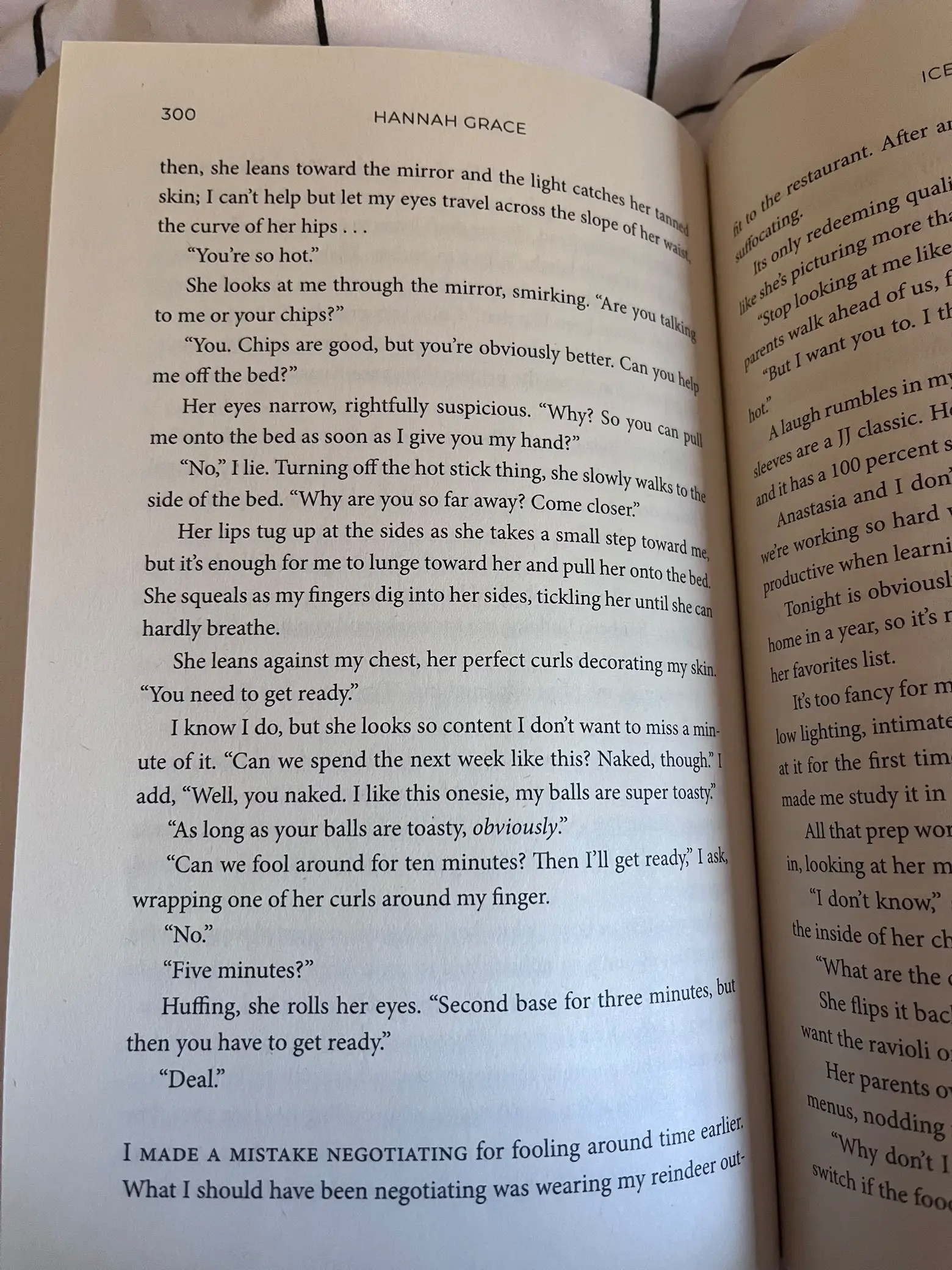Ever wondered how to turn awkward silences into meaningful conversations? Well, page 136 of the book Icebreaker holds some serious game-changing insights. This isn’t just another self-help book; it’s your ultimate guide to mastering the art of connecting with people. Whether you're at a networking event, a first date, or even a family gathering, this book will equip you with the tools you need to break the ice like a pro.
Now, if you're anything like me, you've probably found yourself in those dreaded situations where the conversation just dies out. You’re left standing there, sipping your drink awkwardly, wondering how you ended up in this predicament. But fear not! Page 136 is here to save the day. It dives deep into the psychology of human interaction and provides practical tips that anyone can use.
What makes this book stand out is its focus on authenticity. It’s not about pretending to be someone you’re not or forcing conversations that feel fake. Instead, it’s about understanding the dynamics of communication and leveraging them to build genuine connections. So, if you’re ready to level up your social skills, keep reading because we’re about to uncover some serious gold.
- Who Is Luke Combs Voting For Unveiling The Country Starrsquos Political Views
- The Riflemans Son A Journey Through Legacy History And Impact
What’s an Icebreaker Anyway?
Before we dive headfirst into page 136, let’s talk about what an icebreaker really is. In simple terms, an icebreaker is anything that helps ease tension or discomfort in social situations. It could be a question, a story, or even a playful observation. The goal is to create a bridge between two people who might otherwise struggle to find common ground.
Icebreakers are especially important in professional settings. Imagine walking into a room full of strangers at a business conference. Without an icebreaker, you might feel intimidated or unsure of how to approach people. But with the right tools, you can transform that fear into confidence and start building valuable relationships.
And let’s not forget about personal settings too. Whether you’re meeting your partner’s family for the first time or trying to connect with new friends, icebreakers can make all the difference. They help break down barriers and create a more relaxed atmosphere where everyone feels comfortable expressing themselves.
- Ribert Plant The Voice That Shook The Music World
- Mira Murati The Inspiring Journey Of Teslas Chief Battery Engineer And Her Married Life
The Magic of Page 136
So, what exactly makes page 136 so special? Well, it’s where the book transitions from theory to action. Up until this point, you’ve been learning about the importance of body language, active listening, and emotional intelligence. But page 136 takes things to the next level by providing actionable strategies that you can start implementing right away.
One of the key takeaways from this page is the concept of “micro-affirmations.” These are small gestures or comments that show genuine interest in the other person. For example, instead of asking a generic question like “How are you?” you might say something like “I love your shoes! Where did you get them?” It’s these little details that can make a big impact and set the tone for a deeper conversation.
Another highlight of page 136 is the emphasis on storytelling. Humans are wired to connect through stories, so sharing a personal anecdote or asking someone to share theirs can be incredibly powerful. It creates a sense of vulnerability and authenticity that fosters trust and understanding.
Why Should You Care About Breaking Ice?
Here’s the thing: whether you like it or not, social skills matter. In today’s fast-paced world, being able to communicate effectively is a crucial life skill. And let’s be real, no one wants to be that person who stands in the corner at parties or avoids networking events altogether.
Breaking ice isn’t just about making small talk; it’s about building relationships. Whether you’re looking to advance your career, find love, or simply make new friends, the ability to connect with others is essential. And the good news is, it’s a skill that can be learned and improved over time.
Think about it this way: every successful relationship, whether personal or professional, starts with a single conversation. By mastering the art of breaking ice, you’re opening up endless possibilities for growth and connection.
Common Mistakes People Make When Breaking Ice
Now that we’ve established why breaking ice is important, let’s talk about some common mistakes people make. One of the biggest ones is over-relying on clichéd questions like “What do you do for a living?” While it’s a safe starting point, it can come across as insincere or even boring.
Another mistake is focusing too much on yourself. Sure, sharing a bit about your own life is important, but the key to successful conversations is showing genuine interest in the other person. Ask open-ended questions that encourage them to share their thoughts and experiences.
Finally, don’t underestimate the power of non-verbal communication. Your body language, tone of voice, and even your facial expressions can either enhance or sabotage a conversation. Make sure you’re sending the right signals by maintaining eye contact, smiling, and using appropriate gestures.
How to Avoid Awkward Silences
Awkward silences are the bane of every conversation. But here’s the secret: they don’t have to be. The key is to always have a few backup questions or topics ready to go. For example, you could ask about the other person’s hobbies, travel experiences, or favorite books. Or, if you’re in a professional setting, you could discuss industry trends or upcoming events.
Another trick is to keep an eye on the news or current events. Having a few talking points about recent developments can help keep the conversation flowing smoothly. Just be mindful of sensitive topics like politics or religion, especially in mixed company.
Practical Tips from Page 136
Now that we’ve covered the basics, let’s dive into some practical tips from page 136. First and foremost, always come prepared. Whether you’re attending a networking event or meeting someone new, do your research ahead of time. Knowing a little bit about the other person or the event can give you a great starting point for conversation.
Secondly, practice active listening. This means fully engaging with what the other person is saying, rather than just waiting for your turn to speak. Show that you’re interested by nodding, asking follow-up questions, and using verbal cues like “That’s fascinating” or “Tell me more.”
Lastly, don’t be afraid to be vulnerable. Sharing a personal story or admitting to a mistake can create a deeper connection with the other person. It shows that you’re approachable and willing to open up, which can encourage them to do the same.
Using Humor to Break the Ice
Humor is one of the most powerful tools in your arsenal when it comes to breaking ice. A well-timed joke or lighthearted comment can instantly put people at ease and make them more receptive to conversation. But be careful not to overdo it or rely on offensive or inappropriate humor.
One effective strategy is to use self-deprecating humor. Making fun of yourself in a good-natured way can make you appear more relatable and down-to-earth. Just make sure you’re not being overly critical or negative about yourself, as this can have the opposite effect.
Real-Life Examples of Successful Icebreakers
To give you a better idea of how these strategies work in practice, let’s look at a few real-life examples. Imagine you’re at a networking event and you strike up a conversation with someone who works in a completely different industry. Instead of asking “What do you do?” you might say something like “Wow, I’ve never met anyone who works in [industry]. What’s a typical day like for you?”
Or, let’s say you’re on a first date and you want to ease the tension. You could start with a playful observation like “I can’t believe we both ordered the same thing. Are you trying to tell me something?” It’s light, fun, and sets the tone for a more relaxed conversation.
Finally, consider a scenario where you’re meeting a new colleague. Instead of just introducing yourself, you might say something like “I hear you’re the go-to person for [specific skill]. I’d love to pick your brain sometime.” This shows that you value their expertise and are eager to learn from them.
The Importance of Emotional Intelligence
Emotional intelligence, or EQ, plays a crucial role in breaking ice. It’s the ability to recognize and understand emotions in yourself and others, and to use that awareness to guide your interactions. People with high EQ are often better at reading social cues, managing conflicts, and building strong relationships.
One of the key components of EQ is empathy. This involves putting yourself in someone else’s shoes and trying to see things from their perspective. When you approach conversations with empathy, you’re more likely to connect with others on a deeper level.
Another important aspect of EQ is self-awareness. This means being conscious of your own emotions and how they affect your behavior. If you’re feeling anxious or stressed, for example, it might impact how you communicate with others. By acknowledging these feelings and addressing them, you can maintain a more positive and productive conversation.
Building Your EQ Through Practice
Like any skill, emotional intelligence can be developed through practice. Start by paying attention to your own emotions and how they influence your interactions with others. Keep a journal or use a mindfulness app to track your progress.
Next, focus on improving your ability to read social cues. Pay attention to body language, tone of voice, and facial expressions. Practice observing these signals in everyday conversations and try to interpret what they might mean.
Conclusion: Take Action Today
So there you have it, folks. Breaking ice doesn’t have to be scary or intimidating. With the right mindset and tools, you can transform awkward silences into meaningful connections. Page 136 of the book Icebreaker is your roadmap to success, offering practical tips and strategies that anyone can use.
Now it’s your turn to take action. Whether you’re attending a networking event, going on a first date, or simply trying to make new friends, remember to come prepared, practice active listening, and show genuine interest in the other person. And don’t forget to sprinkle in a little humor and vulnerability to keep things light and fun.
So, what are you waiting for? Grab a copy of the book, turn to page 136, and start breaking those barriers. And when you’re done, be sure to share your experiences in the comments below. We’d love to hear how these tips worked for you!
Table of Contents
- What’s an Icebreaker Anyway?
- The Magic of Page 136
- Why Should You Care About Breaking Ice?
- Common Mistakes People Make When Breaking Ice
- How to Avoid Awkward Silences
- Practical Tips from Page 136
- Using Humor to Break the Ice
- Real-Life Examples of Successful Icebreakers
- The Importance of Emotional Intelligence
- Building Your EQ Through Practice
- Billie Eilish Images Your Ultimate Visual Guide
- Meet The Children Of Prince William A Royal Journey Into Their Lives


